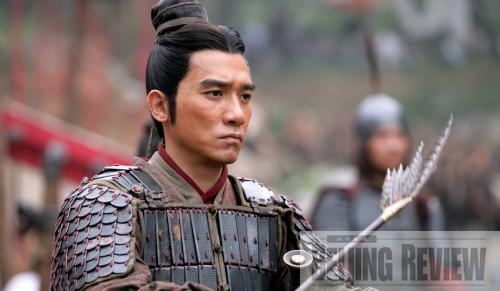|
 |
|
PREPARING FOR BATTLE: Award-winning actor Tony Leung in Red Cliff (COURTESY OF MAGNET RELEASING) |
For those fascinated with both Asian action movies and Hollywood blockbusters, Chinese director John Woo is back. This time, the action-cinema master has stepped off the American film industry's red carpet to focus his directorial talents on the Chinese-language war epic Red Cliff, starring award-winning actor Tony Leung.
"I've been thinking of making this film for 20 years," Woo told a group of reporters during a publicity event in New York in mid-October, one month before Red Cliff's American debut on November 18. Woo came to the United States for the 45th Chicago International Film Festival, bringing Red Cliff with him.
The story of Red Cliff, depicting a battle of significant historical importance that took place 1,800 years ago, is widely known by Chinese and other Asian people from its reference in the classic Chinese novel Romance of the Three Kingdoms. It's a story about the great intelligence and bravery of the ancient Chinese, who, though greatly outnumbered, managed to defeat their enemies.
"It is a film I had long dreamed of making, ever since I read about the heroes from that glorious time in history," Woo said.
Woo, an established action movie director in Asia, made the move to Hollywood over 15 years ago to expand his personal and directorial horizons. His involvement with the megabudget American films Face/Off, starring Nicolas Cage and John Travolta, and Mission: Impossible II, featuring Tom Cruise, made his name known throughout the United States.
Woo has successfully merged the cross-pacific film styles in Red Cliff. The most expensive Asian-financed film to date with an estimated budget of $80 million, Red Cliff reaped $124 million and broke the box office record previously held by Titanic in China, when the first part of the Chinese movie was released in Asia last July.
According to Woo, his production team received overwhelming support from both the Chinese Government and local people. Around 2,000 people worked almost everyday during the production, with 700 to 1,500 real Chinese soldiers portraying the fighters in the film, he said. "It's like an actual war and I myself like a general," Woo joked.
It took about three years of planning and one year of pre-production, before principal photography on Red Cliff commenced in April 2007 in Zhuozhou, Hebei Province, a one hour drive from Beijing.
Since the outset of the film's production, Woo wanted to make Red Cliff an international sensation. "My goal is for this film to rise above cultural and historical barriers, so that the Western audience feels as if they were watching an Asian Troy, while the Eastern audience can discover new perspectives on a familiar story," he said.
A major obstacle Woo had to overcome was presenting Red Cliff, a film rich in history and cultural connotations, to an audience unfamiliar with the movie's setting or time period. "I tried to make this film more human instead of a historical type," Woo said.
To cater to different audiences, Woo produced two versions of the film: a two-part, five-hour version for Asian audiences and a slimmed-down single two-and-half-hour version for audiences in other countries and regions.
While the main plot and characters remained the same, quite a few changes were made to the two versions. For Asian audiences, especially those in China, Japan and Korea, who are familiar with the story, Woo said he put more emphasis on developing each character and showing their intertwining relationships. For Western audiences who do not know much about the history, Woo focused on the main story and the key characters.
"We wanted to make a Hollywood blockbuster in Chinese that would appeal to non-Asian audiences as well. We worked very hard to create a version of the film that maintains the integrity of the action and character development of the story, while exercising some of the cultural details that could be considered unnecessary for Western audiences not intimately familiar with the historical novel," noted producer Terence Chang, Woo's long-time collaborator.
(Reporting from New York) | 